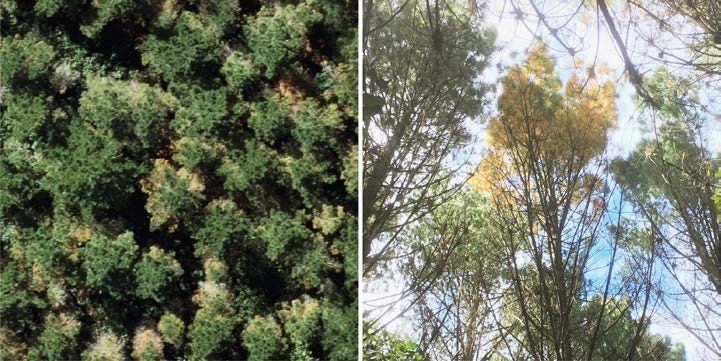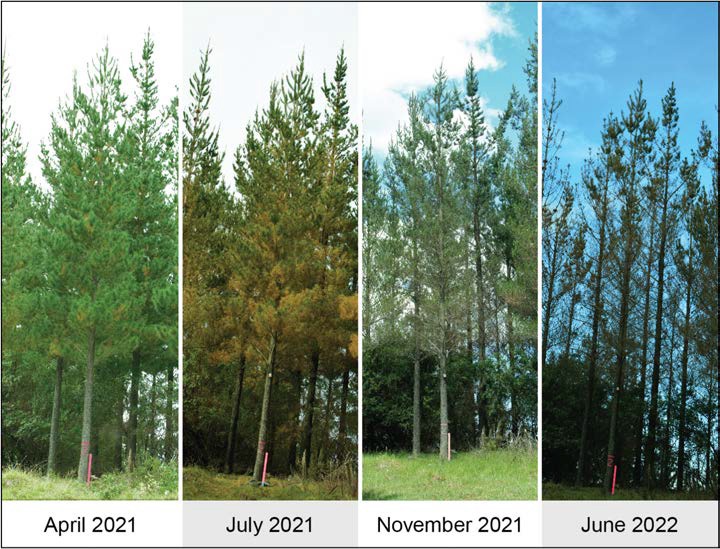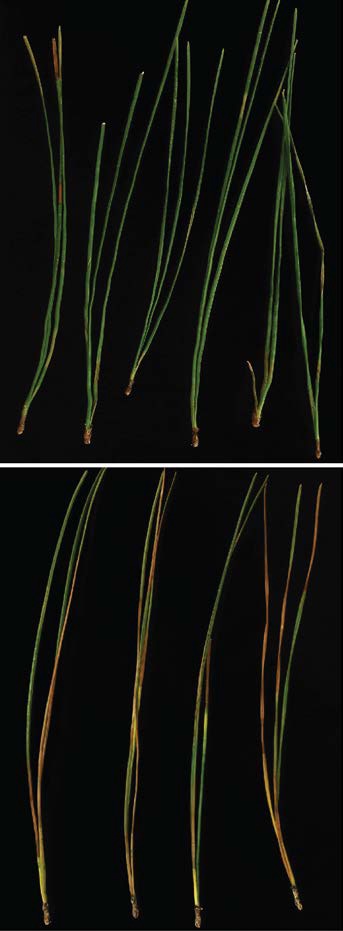PESTS AND DISEASES OF FORESTRY IN NEW ZEALAND
Copper a control option for red needle cast
Scion is the leading provider of forest-related knowledge in New Zealand
Formerly known as the Forest Research Institute, Scion has been a leader in research relating to forest health for over 50 years. The Rotorua-based Crown Research Institute continues to provide science that will protect all forests from damage caused by insect pests, pathogens and weeds. The information presented below arises from these research activities.
From Forest Health News 309, July 2022
In an important step in the development of control recommendations for red needle cast (RNC), a recent open access paper1 has shown that low-volume aerial applications of cuprous oxide can reduce the severity of the disease.
Red needle cast is a foliar disease of radiata pine that has impacted plantations in New Zealand since at least 2008. It is caused by Phytophthora pluvialis and occasionally Phytophthora kernoviae. The disease can cause significant needle loss in winter and spring, leading to substantial growth losses during the following growth season. Laboratory and potted tree trials conducted at Scion had previously demonstrated that copper showed promise for controlling the disease, but control of the disease in plantations had not been tested. Until now, no control recommendations were available for the disease.
Significant disease outbreaks in 2015 and 2016 in several Central North Island plantations prompted Mike Baker, a Technical Forestry Manager at Manulife (formerly Hancock Forest Management), to reach out to Scion pathologists to propose the first operational-scale copper trials. This began an ongoing partnership between Scion and Manulife, with copper trials implemented and assessed in mature stands at Kinleith Forest in the Central North Island annually from 2017, first under the Needle Disease Strategy, and then the Resilient Forests Programme2.
Results from the 2017 and 2019 trials demonstrated that cuprous oxide applied at 0.855 kg ha-1 active ingredient – the standard dose currently used to control Dothistroma needle blight (DNB) – significantly reduced RNC severity.
These trials were also the first to investigate optimal spray timing for control of RNC, testing the hypothesis that late summer or autumn sprays may be best. Spray treatments in November, February and April (or May) were tested in 2018 and 2019; however, no consistent effect of spray timing was observed.

Generally, disease severity was reduced under all three spray timings compared to the unsprayed control; however, differences were not always statistically significant. Disease levels were relatively low during this period when spray timing was tested, and further trials are required to test this aspect under higher disease pressure.
The finding that cuprous oxide applied at the industry standard rate for DNB can reduce RNC severity is an important development for the New Zealand forestry industry. There is a well-developed programme for the control of DNB in New Zealand, coordinated by the New Zealand Forest Owners Association Dothistroma Control Committee, which is now in its 56th year. Copper is applied in late spring (November) for control of DNB, with a second spray in late summer (February) if disease severity passes action thresholds.
The November and February spray applications seem effective against RNC and could be convenient for control of this disease. However, the rapid development of RNC symptoms within a year and often lack of repeated severe epidemics at sites year-on-year will make design of a targeted control regime challenging. RNC epidemics can develop on trees that appear green and healthy in autumn, but then become severely defoliated by the following spring. A more reactive control programme may be necessary for RNC, with more frequent surveys from March onwards and copper applications initiated if symptoms develop.

Disease development may peak later in other regions.
Current work under the Resilient Forests Programme
Control recommendations. Scion and Manulife continue to work closely together, with an ongoing copper trial series established at Kinleith Forest in 2019 to (1) investigate optimal spray timing (February vs April) and (2) quantify disease impacts on growth to support cost benefit analysis of control operations. This year, Scion has expanded these operational control trials to forests on the east coast of the North Island in partnership with Juken and support from the Dothistroma Control Committee.
Autonomous forest health monitoring. Under the Resilient Forests Programme, Scion is working in partnership with Indufor to develop a prototype forest monitoring framework that will allow growers to monitor the health of their forests using satellite imagery. This platform will allow foresters to assess the impacts of foliar diseases at scale and will feedback into the development of an epidemiological model that will quantify impact and help with decision making of where and when to spray.
A prototype can be found here: www.indufor.co.nz/blog/post/red-needle- cast-detection
Disease epidemiology. Scion pathologists continue to research the biology and epidemiology of the pathogens causing RNC and DNB to understand the drivers behind variation in disease expression and determine the importance of prior or current disease levels in predicting future disease. This knowledge, together with remote sensing data from our forest monitoring framework, will be incorporated into an epidemiological model that will support disease forecasting, which will improve the management of these diseases into the future.
Disease impacts. Scion is currently assessing wood core data from trees at Kinleith with known disease histories to quantify disease impacts on growth. This work will be expanded later this year, with coring from trees with various disease histories from North Island forests along the East Coast in September.

Top: Early symptoms. Bottom: Later symptoms.
Call for red needle cast observations
Scion researchers are calling out to foresters to report observations of red needle cast to support the development of an autonomous forest health monitoring platform.
Symptoms to look out for
Red needle cast is a foliar disease of radiata pine that has impacted plantations in New Zealand since at least 2008. Olive coloured lesions on needles that contain black, resinous bands, are characteristic symptoms of the disease. Lesions quickly turn khaki in colour and affected needles become yellow or red, before being readily cast from the tree. The timing of disease expression varies between sites and years, but generally the first symptoms will be seen over autumn and winter on the lower branches of infected trees. Under conducive conditions, the disease will rapidly spread through the canopy of affected and neighbouring trees causing affected needle fascicles to be cast by the end of spring. It is not uncommon to find affected trees that were completely green at the start of autumn severely defoliated by spring.
Sampling and reporting
Please report sightings and send photos to: emily.mclay@scionresearch.com
If possible, please collect and submit samples to Scion’s Forest Health Reference Laboratory for pathogen confirmation. Collect cuttings from a few affected branches (about 20 cm in length), place in a plastic bag and keep refrigerated before couriering as soon as possible. Sample information, contact information, and delivery details are all available at: www.scionresearch.com/forest-health- diagnostics
1 Fraser S, Baker M, Pearse G, Todoroki C, Estarija HJ, Hood I, Bulman LS, Somchit C, Rolando C 2022. Efficacy and optimal timing of low-volume aerial applications of copper fungicides for the control of red needle cast of pine. New Zealand Journal of Forestry Science 52: 18 https://nzjforestryscience.nz/index.php/nzjfs/article/view/211
2 Both funded by the Forest Growers Levy Trust and Scion SSIF (Strategic Science Investment Fund from MBIE).
This information is intended for general interest only. It is not intended to be a substitute for specific specialist advice on any matter and should not be relied on for that purpose. Scion will not be liable for any direct, indirect, incidental, special, consequential or exemplary damages, loss of profits, or any other intangible losses that result from using the information provided on this site.
(Scion is the trading name of the New Zealand Forest Research Institute Limited.)

 Farm Forestry New Zealand
Farm Forestry New Zealand

